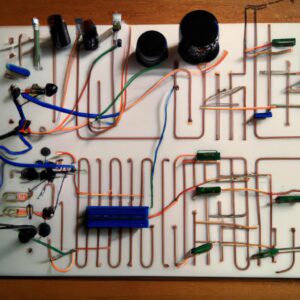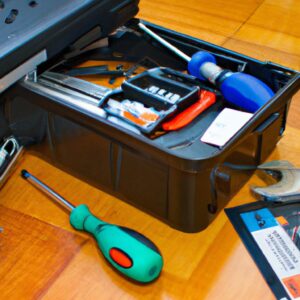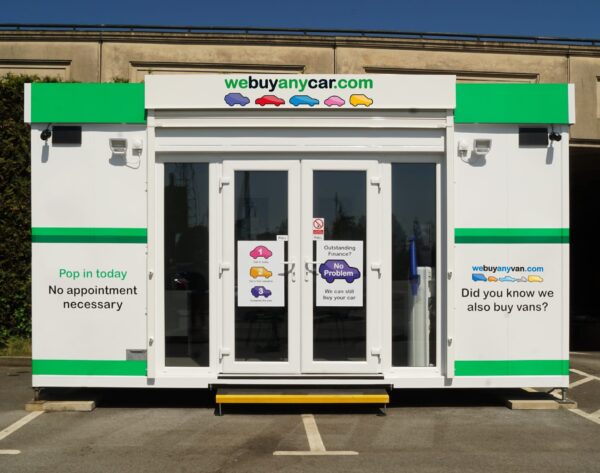Uncover the World of DIY Electronics: Build Your Own Projects!

Exploring the World of DIY Electronics Projects
Do-it-yourself (DIY) electronics projects can be a rewarding experience for any tech enthusiast. Not only do they allow you to learn more about the world of electronics, but they can also provide a creative outlet for those who are looking to unleash their inner inventor. In this guide, you’ll find a comprehensive overview of all that goes into a successful DIY electronics project, from choosing the right components and tools to assembling, testing, and troubleshooting.
DIY electronics projects involve taking electronic components such as resistors, transistors, capacitors, and microchips to create a device or system. These projects can range from more basic tasks like creating a simple circuit to complex endeavors like setting up a laser cutting machine. So, whatever your skill level, with a little research and creativity, there is likely an interesting project that you can tackle.
In order to get started, it is important to understand the basics of the tools and components used in DIY electronics projects. That means understanding things such as the purpose of different electronic components, what type of tools you need, and how to use them.
Tools and Components Used in DIY Electronics Projects
DIY electronics projects are a great way to explore the world of technology and using it to create something unique and useful. To do so, however, you will need the right set of tools and components. Here we will discuss what these tools and components are, and why they are essential to successfully completing your project.
Essential Tools
The essential tools needed for any electronics project include a soldering iron, wire cutters and strippers, multimeter, and soldering paste. The soldering iron is used to join electrical components together, while the wire cutters and strippers allow you to easily cut and strip circuit wires. The multimeter is used to measure voltage, current, and resistance, while the soldering paste provides a protective coating when soldering parts.
Components
Along with the essential tools, you will need to have the right components available to complete your project. These components can include resistors, capacitors, diodes, transistors, microcontrollers, and more. Understanding the function of each component and how it works is the key to being able to select the right one for your project.
Common Supplies
In addition to the tools and components, you will also need some basic supplies to help build and test your project. These supplies can include solder, wire, tape, clips, glue, and other small items that you may need.
Why Knowing the Tools and Components is Important
Understanding the different tools and components used in DIY electronics projects is important for ensuring that the project is completed safely and correctly. Additionally, it can also help to save time and money by helping you to select the right parts for the job. By taking the time to learn about the tools and components, you can increase your chances of success when it comes to completing a DIY electronics project.
Choosing the Right Project for You
When it comes to DIY electronics projects, there are countless options out there. It can be difficult to figure out which project is right for you, but with a little research and planning, you can find a project that fits your skill level, budget and interests.
First, take a look at the various components required for your project. Do you have access to the tools and materials needed? If not, what resources do you need to secure in order to make the project a reality? Researching the components ahead of time will help you gain an understanding of how much the project will cost and whether or not it’s within your budget.
It’s also important to consider the level of difficulty for each project. While challenging projects have their place, beginners should start out with simpler projects that don’t require complicated programming or advanced technical skills. Once you’ve built up your confidence and knowledge base with basic projects, you can move onto more complex ones.
Lastly, think about how the project can benefit you. Will you be able to use the project on its own, or as part of a larger system? Does the project have a practical application around your home or workplace? If you can’t answer yes to these questions, the project may not be a good fit.
By taking the time to do your research, you can ensure that you find the right DIY electronics project for you.
Building a DIY Electronics Project
Building a DIY electronics project can be an incredibly rewarding experience. Whether you are a beginner or experienced hobbyist, you’ll benefit from understanding the basics of the building process. In this section we’ll provide a brief overview of the steps involved in creating a DIY electronics project.
The first step is assembling your components. This includes identifying the necessary components and then physically connecting them together to form a circuit. Once you have done this, it is important to test your project and make sure everything is working as planned. If there are any issues, troubleshooting will help you diagnose and solve the problem. Finally, you may need to make adjustments to your project in order to get it working the way you intended.
Once you have gone through these four steps (assembling components, testing, troubleshooting, and making adjustments), your project should be complete and ready to use. Remember to always practice safety precautions when handling electronics equipment, such as wearing eye protection and following product instructions carefully.
Technology related to DIY electronics projects
Advances in technology have made it easier than ever to participate in DIY electronics projects. New tools, components, and resources have been developed, allowing hobbyists to access parts they wouldn’t normally have access to. Many of these new tools are designed with ease-of-use in mind, making it easier for less experienced hobbyists or those just starting out to get involved.
The internet has also made it easier to find resources on various topics related to DIY electronics projects. There are countless forums, websites, and blogs dedicated to providing advice and support for DIY electronics enthusiasts. With the help of these resources, hobbyists can easily stay up to date on the latest news and advancements in the world of DIY electronics.
Additionally, newer technologies such as 3D printing have opened up a world of possibilities for DIY electronics projects. 3D printing allows hobbyists to quickly print off parts and components they need for their projects without waiting for parts to be delivered or having to buy them at a store.
Benefits of DIY Electronics Projects
DIY electronics projects are a fun and rewarding way to learn about electronics. Not only can you enjoy the satisfaction of creating something from scratch, but you can also develop valuable skills that can be applied to a variety of situations. Working with electronics can provide both physical and mental benefits.
Physical Benefits
By participating in DIY electronics projects, you can develop a better understanding of how electrical components interact with each other. Learning the basics of resistor and capacitor values, soldering techniques, and circuit design can help you complete more comprehensive electronic projects down the line. Practical knowledge of useful tools such as multimeters and oscilloscopes can also be gained.
Mental Benefits
In addition to physical benefits, working on DIY electronics projects can also benefit your mental wellbeing. Building DIY projects requires patience, perseverance, and problem solving skills. You will be challenged to come up with creative solutions, think outside the box, and work through the trial and error process. When you finally finish a project, you’ll feel a sense of accomplishment that comes from seeing something you built with your own hands.
Safety Considerations
When working with any kind of electronic project, safety should always come first. DIY electronics projects require a strict adherence to safety protocols, as mistakes can have disastrous consequences. Be sure to always wear safety goggles and other protective equipment if working with live electricity or soldering irons. Additionally, always double check your circuit before connecting it to a power source.
A few other safety considerations to keep in mind when working on DIY electronics projects include:
- Ensure adequate ventilation as some components may release fumes.
- Always use insulated tools when handling wires.
- Keep all flammable liquids far away from the work area.
- Be aware of any sharp edges or points that could cause injury.
By following these safety guidelines, DIY electronics projects can be a fun and rewarding experience. The importance of safety cannot be overstated, so always double check before powering up a circuit!
Troubleshooting and Q&A
DIY electronics projects can often have unexpected challenges, but don’t let that stop you from getting creative. Before you make any major changes to your project, it is important to identify where the problem lies and why it may be occurring. There are several tips you can follow to troubleshoot any problems with your project.
- First, retrace your steps and review the instructions to verify that all connections are secure and in the correct order.
- Check all the components of the circuit to make sure none are damaged or corroded.
- Check the power source and look for any loose wires or connections.
- Consult the documentation for the project and make sure you understand it completely. Read up on the components you are using and adjust the settings accordingly.
If you still cannot locate the problem, ask a friend or mentor for help or join an online forum to seek advice from other enthusiasts. Many forums are tailored to specific topics, such as DIY electronics projects, and feature experienced members who can help you find solutions.
Creative Applications of DIY Electronics Projects
DIY electronics projects are becoming an increasingly popular way to explore the world of electronics. With a few basic tools and components, people of all ages and skill levels can create fun and engaging projects. From automated pet feeders to solar-powered gadgets, DIY electronics projects provide an excellent opportunity to learn more about technology and even produce something tangible. Here are some examples of creative applications of DIY electronics projects.
- Home Automation: You can use DIY electronics projects to automate your home. From connected lighting systems to security cameras, you can set up a variety of automated features that can be controlled with a smartphone or voice assistant.
- Robotics: Robotics projects are especially popular and accessible thanks to the availability of microcontrollers that are relatively easy to program. You can build simple robots such as a wheeled line follower or a more complex robot that can be programmed to explore an environment.
- Arduino Projects: Arduino boards are some of the most popular platforms for DIY electronics projects. They offer a low cost and powerful platform for building everything from drone projects to interactive displays.
- DIY Drones: Drone technology has advanced rapidly in recent years, and you can now make your own drone with the help of DIY electronics projects. Aside from its practical applications, such as aerial photography, it can also be a great way to have some fun and get introduced to the world of drones.
These are just a few examples of the creative possibilities offered by DIY electronics projects. There are many more applications that can be explored, from virtual reality to water monitoring.
Conclusion
DIY electronics projects are an enjoyable and rewarding experience, unique in that they combine real-world building exercises with expanding knowledge and creativity. Through these kinds of projects, it is possible to gain a better understanding of the principles of electronics engineering, expand problem solving and analytical skills, and build something tangible in the process. No matter your level of experience or expertise, DIY electronics projects are an accessible way to have fun and learn something new.
We hope this guide has provided you with a better understanding of what DIY electronics projects entail, as well as the tools and components needed to get started. So why not give it a go! Who knows where it may lead.
Suggested Resources
There are many online resources and books that can provide useful reference materials for DIY electronics projects. Popular websites like Adafruit, Spark Fun, and Arduino Projects are filled with guides, tutorials, and advice for beginner projects. Books such as Make: Electronics by Charles Platt and Practical Electronics for Inventors by Paul Scherz are also excellent resources. Additionally, online forums like Reddit’s r/diyelectronics are ideal places to ask questions and get help from more experienced DIY electronics builders.
Supplemental Information for Advanced DIY Electronics Projects
For readers looking to take the next step in DIY electronics projects, there is a wide array of resources available, both in terms of online references and print publications. The following is a list of some of the most helpful sources for advanced electronics projects.
- EagleCAD – This is a powerful and feature-rich CAD suite that makes designing PCBs fast and intuitive.
- SparkFun – SparkFun is an excellent source for components and tutorials to help you with your DIY electronics projects.
- Instructables – Instructables offers free step-by-step instructions for all kinds of DIY projects, including electronics.
- Make Magazine – Make Magazine provides interesting articles, reviews, and instructional videos about DIY electronics projects.
- Arduino – Arduino provides a comprehensive platform for developing electronics projects. There are a wealth of books, tutorials, and software available to help you get started.
Whether you’re just starting out or looking to take your skills to the next level, these resources will help you make the most of your DIY electronics projects.
comments: 0






